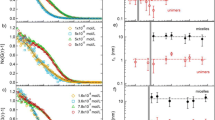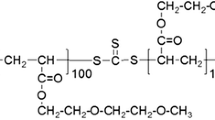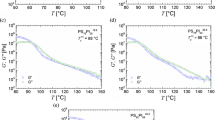Abstract
ABA-type triblock copolymers form micellar structures consisting of B-rich cores and A-rich coronas in A-selective solvents. The relaxation of A corona is known to be qualitatively similar to but quantitatively different from that of a star-shaped A chain due to the geometric (spatial) constraint by the core and the thermodynamic (osmotic) constraint. The effect of the geometric constraint on the block dynamics can be modeled by a chain with one end grafted onto an impenetrable wall. We show that the impenetrable wall slightly accelerates the end-to-end vector relaxation in a direction normal to the wall while it slightly decelerates the viscoelastic terminal relaxation. To test this prediction, we performed linear viscoelastic measurements for model systems: For polystyrene–polyisoprene–polystyrene (SIS) triblock copolymers in S-selective solvent (diethyl phthalate) forming micelles, the viscoelastic relaxation of unentangled S blocks (corona blocks) was indeed slower compared with that of star-branched S chains having the same molecular weight. Nevertheless, the deceleration was stronger than that expected from our theory, and possible reasons were discussed.








Similar content being viewed by others
References
Alig I, Floudas G, Avgeropoulos A, Hadjichristidis N (1997) Junction point fluctuations in microphase separated polystyrene-polyisoprene-polystyrene triblock copolymer melts. A dielectric and rheological investigation. Macromolecules 30:5004–5011
Ball RC, Mcleish TCB (1989) Dynamic dilution and the viscosity of star polymer melts. Macromolecules 22:1911–1913
Chen Q, Matsumiya Y, Iwamoto T, Nishida K, Kanaya T, Watanabe H, Takano A, Matsuoka K, Matsushita Y (2012) Dielectric behavior of guest cis-polyisoprene confined in spherical microdomain of triblock copolymer. Macromolecules 45:2809–2819
Chen Q, Uno A, Matsumiya Y, Watanabe H (2010) Viscoelastic mode distribution of moderately entangled linear polymers. Nihon Reoroji Gakk 38:187–193
Chen Q, Masser H, Shiau H, Liang S, Runt J, Painter PC, Colby RH (2014) Linear viscoelasticity and fourier transform infrared spectroscopy of polyether-ester-sulfonate copolymer ionomers. Macromolecules 47:3635–3644
Daoud M, Cotton JP (1982) Star shaped polymers: a model for the conformation and its concentration dependence. J Phys (Paris) 43:531–538
Gennes De (1979) Scaling Concepts in Polymer Physics. Cornel University Press, New York
Dimarzio EA (1965) Proper accounting of conformations of a polymer near a surface. J Chem Phys 42:2101–2106
Doi M, Edwards SF (1986) The theory of polymer dynamics. Clarendon Press; Oxford University Press, Oxford
Doi M, Kuzuu NY (1980) Rheology of star polymers in concentrated-solutions and melts. J Polym Sci Pol Lett 18:775–780
Evans DJ, Morris GP (2008) Statistical mechanics of nonequilibrium liquids, 2nd edn. Cambridge University Press, Cambridge
Fang L, Takahashi Y, Takano A, Matsushita Y (2013) Molecular weight dependence of viscoelastic properties for symmetric poly(styrene-b-2-vinylpyridine)s in the nanophase separated molten states. Macromolecules 46:7097–7105
Fetters LJ, Lohse DJ, Colby RH (2007) Chain Dimensions and Entanglement Spacings. In: Mark JE (ed) Physical properties of polymers handbook, 2nd ed. Springer, New York, pp 445–452
Fetters LJ, Lohse DJ, Milner ST, Graessley WW (1999) Packing length influence in linear polymer melts on the entanglement, critical, and reptation molecular weights. Macromolecules 32:6847–6851
Ham JS (1957) Viscoelastic theory of branched and cross-linked polymers. J Chem Phys 26:625–633
Hamley IW (2005) Block copolymers in solution: fundamentals and applications. Wiley, England Hoboken, NJ
Kawakatsu T (2004) Statistical physics: an introduction. Springer, Berlin
Koch M, Sommer JU, Blumen A (1997) Polymer chains tethered to impenetrable interfaces: broadening of relaxation spectra. J Chem Phys 106:1248–1256
Kröger M (2004) Simple models for complex nonequilibrium fluids. Phys Rep 390:453–551
Likos CN (2001) Effective interaction in soft condensed matter physics. Phys Rep 348:267–439
Likhtman AE (2012) Viscoelasticity and molecular rheology, in polymer science: a comprehensive reference. In: Matyjaszewski K, Möller M (eds) vol 1. Elsevier, Amsterdam
Lodge TP, Pudil B, Hanley KJ (2002) The full phase behavior for block copolymers in solvents of varying selectivity. Macromolecules 35:4707–4717
Matsumiya Y, Chen Q, Uno A, Watanabe H, Takano A, Matsuoka K, Matsushita Y (2012) Dielectric behavior of styrene-isoprene (si) diblock and siis triblock copolymers: global dynamics of i blocks in spherical and cylindrical domains embedded in glassy S matrix. Macromolecules 45:7050–7060
Müller M, Schmid F (2005) Incorporating fluctuations and dynamics in self-consistent field theories for polymer blends. Adv Polym Sci 185:1058
Okumoto M, Nakamura Y, Norisuye T, Teramoto A (1998) Excluded-volume effects in star polymer solutions: four-arm star polystyrene in benzene. Macromolecules 31:1615–1620
Okumoto M, Terao K, Nakamura Y, Norisuye T, Teramoto A (1997) Excluded-volume effects in star polymer solutions: four-arm star polystyrene in cyclohexane near the theta temperature. Macromolecules 30:7493–7499
Pearson DS, Helfand E (1984) Viscoelastic Properties of star-shaped polymers. Macromolecules 17:888–895
Rouse PE (1953) A Theory of the linear viscoelastic properties of dilute solutions of coiling polymers. J Chem Phys 21:1272–1280
Sato T, Watanabe H, Osaki K, Yao ML (1996) Relaxation of spherical micellar systems of styrene-isoprene diblock copolymers.1. Linear viscoelastic and dielectric behavior. Macromolecules 29:3881–3889
Schausberger A, Schindlauer G, Janeschitz-Kriegl H (1985) Rheol Acta 24:220–227
Sebastian JM, Lai C, Graessley WW, Register RA (2002) Steady-shear rheology of block copolymer melts and concentrated solutions: disordering stress in body-centered-cubic systems. Macromolecules 35:2707–2713
Uneyama T (2009) Coarse-grained Brownian dynamics simulations for symmetric diblock copolymer melts based on the soft dumbbell model, Nihon Reoroji Gakkaishi. J Soc Rheol Jpn 37:81–90
Kampen Van (2007) Stochastic processes in physics and chemistry, 3rd edn. Elsevier, Amsterdam
Van Ruymbeke E, Muliawan EB, Vlassopoulos D, Gao HF, Matyjaszewski K (2011) Melt rheology of star polymers with large number of small arms, prepared by crosslinking poly(n-butyl acrylate) macromonomers via ATRP. Eur Polym J 47:746–751
Watanabe H, Sakamoto T, Kotaka T (1985) Entanglements in linear polystyrenes. Macromolecules 18:1436–1442
Watanabe H, Sato T, Osaki K (1996) Viscoelastic relaxation of styrene-butadiene diblock copolymer micellar systems.1. Behavior in a nonentangling, short polybutadiene matrix. Macromolecules 29:104–112
Watanabe H, Sato T, Osaki K, Matsumiya Y, Anastasiadis SH (1999) Effects of spatial confinement on dielectric relaxation of block copolymers having tail, loop, and bridge conformations. Nihon Reoroji Gakk 27:173–182
Watanabe H, Kanaya T, Takahashi Y (2001) Equilibrium elasticity of diblock copolymer micellar lattice. Macromolecules 34:662–665
Watanabe H, Matsumiya Y (2005) Rheology of diblock copolymer micellar dispersions having soft cores. Macromolecules 38:3808–3819
Williams ML, Landel RF, Ferry JD (1955) The temperature dependence of relaxation mechanisms in amorphous polymers and other glass-forming liquids. J Am Chem Soc 77:3701–3707
Watanabe H, Matsumiya Y, Ishida S, Takigawa T, Yamamoto T, Vlassopoulos D, Roovers J (2005) Nonlinear rheology of multiarm star chains. Macromolecules 38:7404–7415
Zwanzig R, Mountain RD (1965) High-frequency elastic moduli of simple fluids. J Chem Phys 43:4464–4471
Acknowledgments
Q.C. thanks the financial support from the G-COE program at the Institute for Chemical Research, Kyoto University. T.U. thanks the support by Grant-in-Aid (KAKENHI) for Young Scientists B 25800235. The authors thank Prof. Hiroshi Watanabe for continuous support and encouragement on this work. The authors thank Prof. Yo Nakamura for kindly providing star-shaped PS used in this work. The authors thank Prof. Toshiji Kanaya for kindly allowing the authors to do the SAXS measurements in his laboratory.
Author information
Authors and Affiliations
Corresponding author
Appendix:
Appendix:
In this appendix, we show the detailed calculation of the correlation functions and the shear relaxation modulus for the model in the “Theory” section. We first consider the two-and four-body correlation functions defined by Eq. 20. Eqs. 10 and 11 describe the Ornstein-Uhlenbeck processes and can be formally integrated as
where we have defined \(Q_{z} (t)=R_{z} (t)-\sqrt {Nb^{2}/3} \). The two body correlation functions for R x (t), R y (t), and Q z (t) can be calculated straightforwardly.
The two body correlation functions in Eq. 19 become
Because R x (t), R y (t), and Q z (t) are the Gaussian processes, the higher-order correlation functions can be calculated straightforwardly. Here, we note that Eq. A6 contains a non-relaxing component (\(C_{z}^{(2)} \to 1\) at the limit of t → \(\infty )\). The four body correlations can be factorized into the two-body correlations (Van Kampen 2007). Thus, we have
By substituting Eqs. A5–A8 into Eq. 19, we finally have
This gives Eq. 21.
The shear relaxation modulus calculated in the main text (and in this appendix) is for a non-interacting chain. In reality, the chains interact with each other and a chain feels the osmotic pressure field. As we discussed in the main text, this modulates the effective potential for the chain end (6). We briefly consider how this affects the shear relaxation modulus. By the addition of the extra term, the position of the minimum of the effective potential and the expansion coefficient are changed. Then, we may have the following harmonic approximation form instead of Eq 9.
Here, c is a positive constant and \(\bar {{R}}_{\text {mp}} \) is the most probable bond length. The use of Eq. (A9) changes the relaxation time in the z-direction (from 2 τ to c τ) as well as the average end-to-end vector size in the z-direction (from \(\sqrt {Nb^{2}/3} \) to \(\bar {{R}}_{\text {mp}} )\). These changes, however, do not affect the longest relaxation time of the shear relaxation modulus because the longest relaxation time arises from the coupling between the relaxation of the x- or y-direction and the time-independent component in the z-direction (The weight average relaxation time can be affected, although we expect that the effect will not be large.)
Rights and permissions
About this article
Cite this article
Chen, Q., Uneyama, T. Linear viscoelasticity of unentangled corona blocks and star arms. Rheol Acta 53, 701–714 (2014). https://doi.org/10.1007/s00397-014-0790-2
Received:
Revised:
Accepted:
Published:
Issue Date:
DOI: https://doi.org/10.1007/s00397-014-0790-2




